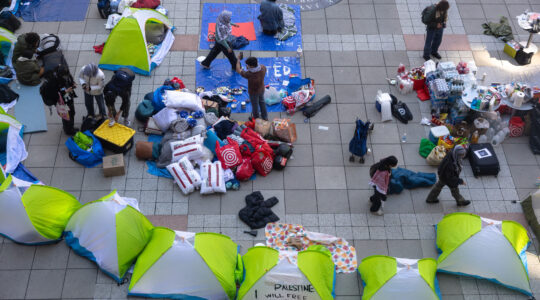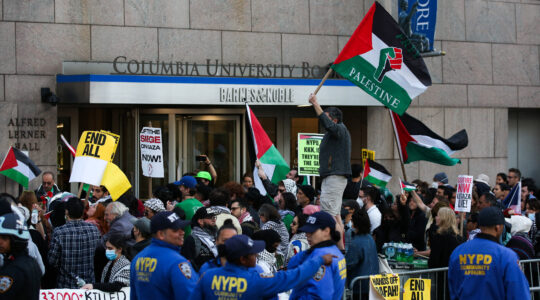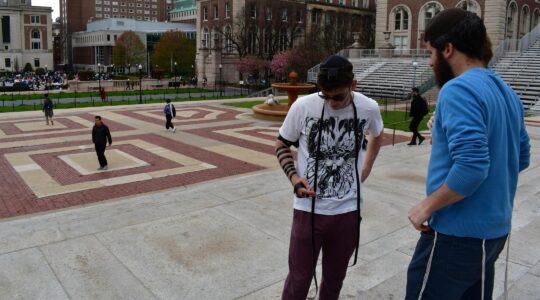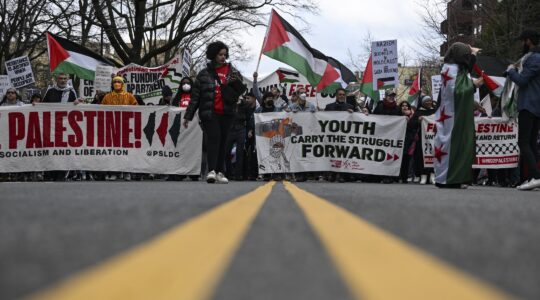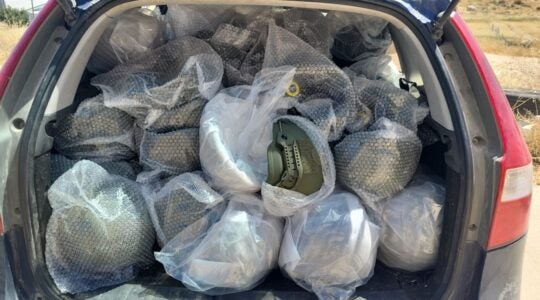REPORTER’S NOTEBOOK
TORONTO (JTA) — The atmosphere was a lot more subdued at this year’s Reform biennial than it was two years ago in San Diego.
Nearly 6,000 people turned out in 2007 to celebrate the largest Jewish religious movement in North America, festively wending their way through a conference so huge it was barely navigable.
This time 3,000 attendees, including more than 600 volunteers from the Toronto Reform community, seemed to be more focused on finding ways to build their congregations and improve their offerings.
“We are a bit more somber than at biennials past,” Union for Reform Judaism President Rabbi Eric Yoffie declared during his Saturday morning sermon, as he described the economic downturn that is forcing Jewish institutions nationwide to slash budgets and restructure.
For its part, the union has collapsed its 14 North American regions into four geographic districts. Most lay leaders said they were reserving judgment on the system, although one East Coast rabbi grumbled that his district head is now in Dallas, a three-hour plane ride away.
In June, the URJ headquarters in New York dismantled its departments and replaced them with consultants, who ran booths in the main conference hall to meet with lay leaders seeking advice in areas from synagogue mergers to youth engagement. The consultation booths were fairly full throughout the four-day gathering.
* * *
This was the first time in 30 years that the Reform biennial was held in Canada, and Toronto made the most of it.
In an opening-night video that should have been titled (G)O Canada, the overwhelmingly south-of-the-border audience was reminded that Canadian Reform history is just as illustrious as that of its southern cousin. Gunther Plaut, author of the movement’s seminal Torah commentary, came from Toronto’s Holy Blossom Temple, as did Maurice Eisendrath, the mid-century president of what was then called the Union of American Hebrew Congregations.
Reform Judaism “is different” in Canada, a parade of Canadian rabbis proclaimed on screen. The fact that they do not recognize patrilineal descent was glossed over, but viewers were reminded that Canadian Reform Jews are more Zionist, more traditional and spend more time in Israel than American Reform Jews.
Take that, Yankee fans.
* * *
Movement conferences are a time for pronouncing new initiatives, but how often are these programs followed up? How many Reform Jews followed Yoffie’s 2005 advice to “lovingly, gently” encourage non-Jewish spouses to convert? How many took his 2007 challenge to make their Shabbats “more meaningful?”
No answers there, but the union’s Nothing But Nets campaign to fight malaria in Sub-Saharan Africa, launched at the 2007 biennial, has saved actual lives. More than 60,000 of them, according to former British Prime Minister Tony Blair, who spoke live via video to the conference.
Malaria causes more than 1 million deaths per year, mostly in Africa. Nothing But Nets is a global campaign to combat the spread of the disease by providing insecticide-treated bed nets to low-income families. A net that costs $10 protects a home. The URJ has raised $580,000 since the 2007 biennial, exceeding its goal of half a million dollars.
That’s not talk; that’s tachlis.
* * *
Blair, who spoke on behalf of the Tony Blair Faith Foundation, which he founded last year to promote understanding and social action between the major faiths, was one of several high-profile speakers to address the biennial.
When moderator Rabbi David Saperstein, director of the Reform movement’s Religious Action Center, had a chance to ask Blair a question, it wasn’t about Blair’s role as the peace envoy to the Middle East of the Quartet (Russia, the United Nations, the United States and the European Union). Rather it was about the 2006 Oscar-winning film “The Queen,” a dramatization of Blair’s first days in office. Did actor Michael Sheen, who played Blair, get him right? Saperstein wanted to know.
Blair, clearly taken by surprise, confessed that he hadn’t actually seen the movie.
“When it came out, I had my weekly audience with the queen,” he said. “She said, ‘I hear there’s a film.’ There was a pause, and I said, ‘Yes, Mum, there is.’ Pause. Then she said, ‘I don’t think I’ll be watching it.’ Another pause, then she said, ‘Will you?’ And I said, ‘Of course not.’ ”
* * *
Dr. Ruth Westheimer wouldn’t have let the queen of England tell her what to do. The diminutive sex therapist, Holocaust survivor and ex-Haganah fighter held forth at a standing-room-only lunch study session Saturday delivering tips on healthy sexuality in her inimitable German accent, which she works to great effect.
During lunch, she told the crowd, a cantor started talking to her about sex.
“I said, not at the table,” Westheimer scolded. “I come from Frankfurt Am Main, from a very Orthodox family. I talk explicitly about sex, but not at the table!”
The rabbis of the Talmud were very wise about sex, she said, as well as everything else.
“They said a man may have sexual intercourse with his wife in any way he wants, even from behind,” she told the audience, pointing out that many women find this position highly pleasurable.
“Now I want all of you in relationships — don’t pick up someone in the hallway, I’m very old-fashioned — to go to your hotel rooms tonight and try a new position,” she ordered. “And call me up afterwards.”
As the jovial crowd spilled out of the meeting room, one congregational president with his arm around his wife announced, “We’re going to do our homework now.”
* * *
The Women of Reform Judaism, which also held its biennial in Toronto last week, launched a program to twin Reform Sisterhoods in North America with their counterparts in Israel.
Sisterhoods are new in Israel’s 25 Reform congregations. One of the five female rabbis from those congregations at last week’s conference said that Israeli women had worked so hard for equality it felt strange to create women-only organizations.
WRJ national board member Resa Davids, who now lives in Jerusalem, used the example of Israel’s 2-year-old Reform Sisterhood at Or Hadash in Haifa to convince 15 other congregations to follow suit.
The next step was to build relationships between those fledgling groups and the more established ones in North America. Instead of a one-way flow of money, Davids wrote up a list of 20 sample projects Sisterhoods in both countries could engage in together. One project suggested sending dreidels to each other and using the different lettering — the “shin” for “sham,” meaning “there,” used on dreidels in the Diaspora, versus the “peh” for “po,” or “here,” on Israeli dreidels — to teach about the differences between Israeli and Diaspora Judaism.
By the end of the hourlong conference session, every Reform Sisterhood in Israel had a North American twin. Some had two or three.
* * *
A big aspect of the URJ restructuring involves greater reliance on the Internet. In his Saturday sermon, Yoffie asked Reform congregations to set up their own synagogue blogs, which he said should be used to stimulate real conversations between members “and not be just an electronic version of your temple newsletter.”
Three separate workshops on Web building and social media were packed, as younger delegates helped talk older delegates through the minefields of Twitter and Evite.
In one session, the audience oohed and aahed as Rabbi Jonathan Blake of the Westchester Reform Temple in Scarsdale, N.Y., displayed his Facebook page on the big screen and showed what happened when Rabbi Phyllis Sommer, a Chicago-area Jewish parenting blogger sitting in the room, tweeted her comments. Look, he pointed out, there are her remarks right there on the screen!
Blake uses Facebook to generate Jewish discussion, he said, noting that he links to a short video blog he prepares every week on the upcoming Torah portion. When congregants show up Saturday morning for Torah study, they are prepared.
Other Reform congregations use Web cameras to broadcast their Shabbat and High Holidays services live for those unable to attend in person, such as the homebound elderly and students away at college.
The URJ offers a wide spectrum of online advice, including live tech support for member congregations embarking on these adventures. They will need it.
